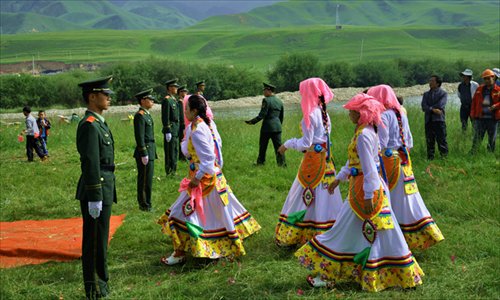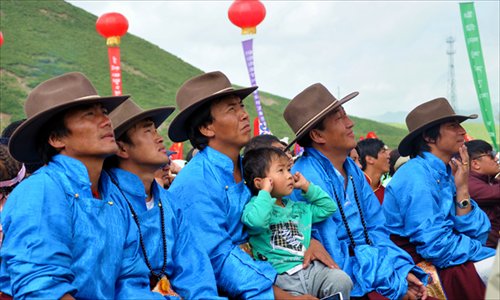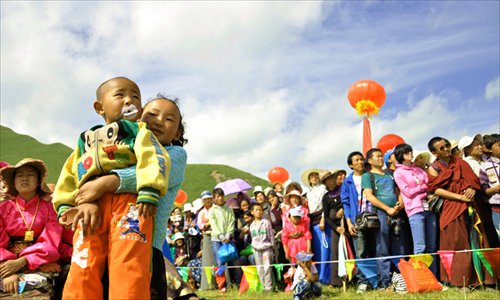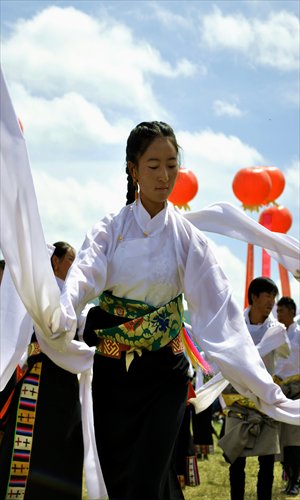The safety factor of Tibetan culture

Four dancers walk toward the stage before their performance.

Gyalpo (middle) and four other dancers from the Shuangcha township government watch the show at the opening ceremony.

Prayer flags

A girl holds her younger brother to give him a better view of the show after sneaking past the security line.

Dondrup from a local Tibetan and Putonghua bilingual school dances during the contest. Photos: Liu Sha/GT
More than 1,800 people, including both Han and Tibetan, danced together to celebrate the annual harvest in Luqu county of Gannan Tibetan Autonomous Prefecture, Gansu Province.
Local authorities have hit on the idea that focusing on culture would be the best way to boost the economy and maintain stability.
The dancers from seven counties of Gannan and from neighboring Tibetan areas in Qinghai and Sichuan provinces formed 22 teams to participate in a contest of guozhuang, a traditional Tibetan form of singing and circle dancing.
The contest, held by the county government of Luqu where 83 percent of population is Tibetan, attracted nearly 3,000 people who set up tents on the grasslands and spent the three-day festival there while watching the contest.
Harmony and stability
Local authorities said they hope such events could promote Tibetan culture and tourism while improving people's well-being and ensuring harmony in Tibetan areas.
Xu Yongquan, deputy head of the publicity department of Gannan, told the Global Times that people who sought to foment hatred or dissatisfaction would never take part in the guozhuang dance, given its core messages of harmony and friendship.
However, the majority of the dancers were picked from people working for local government departments or State-owned enterprises and only two teams were formed by ordinary villagers.
"The government leads first will make ordinary people become more active. We believe that more Tibetan people will come to take part without official instructions, as guozhuang has long been a popular activity in Tibetan areas," said Drolma Jia, director of the contest.
He added that in areas peopled by herders, cultural activities are few and far between, making such events popular.
A Tibetan dancer named Wang Tashi from Shuangcha township in Luqu said if people did not wish to participate, the government would not railroad contests like this through.
County governments have helped purchase dancing outfits, boots and audio equipment for dancers and the winning teams will be rewarded with up to 150,000 yuan ($24,493) in winnings.
Xu said that with 24 people setting themselves on fire last year in Gannan after being incited by the Dalai Lama clique, maintaining stability here remains tricky, but events like guozhuang dance contests can enrich people's lives in a healthy way.
There were no monks among the 24 people, and most of them were poor and uneducated, Xu said.
"People will not be incited easily if they live prosperous and comfortable lives, so we should develop local tourism and cultural industry to provide more job opportunities for them," Xu said.
The guozhuang dance contest as well as a harvest festival lasted three days from August 6 with more than 130 policemen from Luqu at the scene to maintain security.
One onlooker, seated three meters behind the security line, told the Global Times that she likes guozhuang very much but the event organizers should provide seating closer to the stage as some had traveled long distances to be here.
Provincial actions
With more than 2 million people belonging to ethnic minorities in Gansu, promoting minority culture development has been a provincial policy since last year when the State Council gave Gansu the go-ahead to build the nation's first "Chinese Civilization Inheritance and Innovation Zone."
"Building such a zone is not only an effort to promote traditional culture and related industries, but also an important political mission to unite different ethnic minorities in Gansu," Lian Ji, the publicity minister of Gansu Provincial CPC Committee, told the Global Times on August 8.
Other than local activities like guozhuang dance contests, Lian said officials had also launched the building of a public cultural service as an important step forward for the zone.
"We gave television satellite dishes to people living in counties and villages in Gannan for free, giving them access to high-definition television channels," he said.
Meanwhile, the government took back 10,500 illegal dishes, which connected to foreign satellites that might deliver inflammatory and harmful information from the Dalai Lama clique to local people, Lian said.
"We successfully completed a program that will greatly purify people's thoughts and help them resist hostile forces as well as provide positive cultural products," said Lian.
He added that in such a complicated area with different minorities and religions, fighting against hostile forces with cultural means and taking the ideological high ground was vital.